Q&A with Harriet Stanes
November 11th, 2019
When did you decide you wanted to become an illustrator, what prompted this?
The first clue that I might become an illustrator came from my GSCE Art examiner, who made the suggestion to my art teacher whilst looking at my ‘Drama’ themed final exam piece. My chosen subject was a plane spiralling out of control, goodness knows why, but I really wanted to paint a blurred and smudged landscape ‘spinning’ around the edge of the paper. The plane was really incidental!
However I didn’t take this suggestion seriously at all as I really wanted to be a fashion designer. When I was given the opportunity to explore the different areas of the art world during my art foundation course, I then realised that yes, I was far more interested in telling pictorial stories. Next stop was Bath College of Higher Education where I took a Graphic Design degree with a specialisation in illustration which I combined with a keen interest in photography. It wasn’t until a few years later when I moved out to Kenya that my style developed.
I think moving from the UK to a completely new culture helped me notice the quirks of everyday occurrences, normally taken for granted by the local population. I began drawing characters in their everyday lives and highlighting the unusual, from my perspective, by embellishment to exaggerate the content and ultimately put a smile on people’s faces.
What was my favourite childhood book?
For me it is a book’s illustrations which always grab my attention and one book that really stands out for me is The Adventures of Uncle Lubin written and illustrated by W Heath Robinson. Beautiful black and white illustrations which capture more that the moment and sparks the imagination.
How did you come up with the character designs?
The temperaments of each of the Big Five animals are well known and are well described by Ralph, so that was a great starting point.
I injected a little humour by anthropomorphising the animals so that younger readers could begin to identify with the animals. Ralph’s words set the ball rolling right from the scene-setting first pages…’from the earliest day of school’, I drew young animals ‘hand in hand’ (tail to mouth) off on a school outing following their teacher, a traditionally wise owl: a Verreaux's eagle-owl, which is Kenya’s largest owl and happens to have lovely pink eyelids, a feature that no other owl has.
The first clue that I might become an illustrator came from my GSCE Art examiner, who made the suggestion to my art teacher whilst looking at my ‘Drama’ themed final exam piece. My chosen subject was a plane spiralling out of control, goodness knows why, but I really wanted to paint a blurred and smudged landscape ‘spinning’ around the edge of the paper. The plane was really incidental!
However I didn’t take this suggestion seriously at all as I really wanted to be a fashion designer. When I was given the opportunity to explore the different areas of the art world during my art foundation course, I then realised that yes, I was far more interested in telling pictorial stories. Next stop was Bath College of Higher Education where I took a Graphic Design degree with a specialisation in illustration which I combined with a keen interest in photography. It wasn’t until a few years later when I moved out to Kenya that my style developed.
I think moving from the UK to a completely new culture helped me notice the quirks of everyday occurrences, normally taken for granted by the local population. I began drawing characters in their everyday lives and highlighting the unusual, from my perspective, by embellishment to exaggerate the content and ultimately put a smile on people’s faces.
What was my favourite childhood book?
For me it is a book’s illustrations which always grab my attention and one book that really stands out for me is The Adventures of Uncle Lubin written and illustrated by W Heath Robinson. Beautiful black and white illustrations which capture more that the moment and sparks the imagination.
How did you come up with the character designs?
The temperaments of each of the Big Five animals are well known and are well described by Ralph, so that was a great starting point.
I injected a little humour by anthropomorphising the animals so that younger readers could begin to identify with the animals. Ralph’s words set the ball rolling right from the scene-setting first pages…’from the earliest day of school’, I drew young animals ‘hand in hand’ (tail to mouth) off on a school outing following their teacher, a traditionally wise owl: a Verreaux's eagle-owl, which is Kenya’s largest owl and happens to have lovely pink eyelids, a feature that no other owl has.

The lion needed to be a little vain and all about his mane. I gave him a groomed, parted-down-the-side big bouffant hair style.

I have loosely based Clive the elephant on one of Kenya’s largest ‘tuskers’, Satao, who was tragically killed by poachers around the time I began work on The Small Five. Satao’s tusks were so long (at over 2 metres) they almost touched the ground, and he was estimated to have been one of the world’s largest elephants at the time of his death.
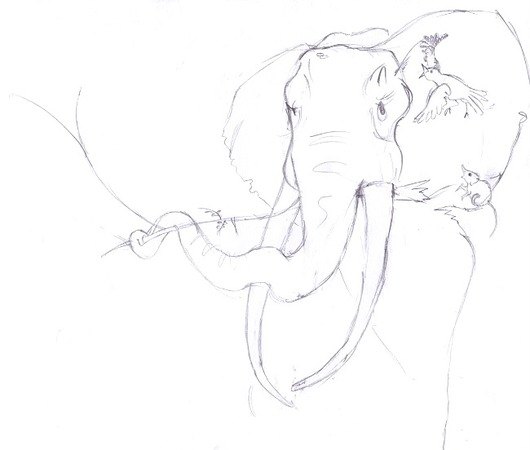
But I think my favourite page is when Doc the Croc is checking on which team is in the lead and referring to his wooden score board, held up, game show style, by a wonderful flouncy burlesque female ostrich. Doc the Croc is a Nile Crocodile. Fortunately for our contestants, Doc is completely the opposite of his more usual fearsome character. (On days outside our tale, he can attack almost anything that gets in his way – including humans venturing down to the riverside!)

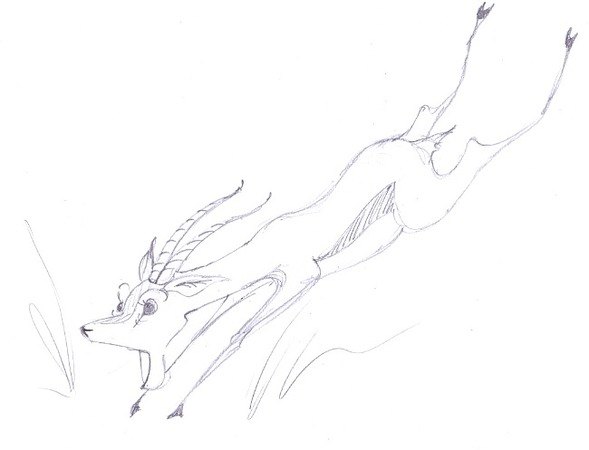
The trickiest character was the ant lion who is so teeny tiny that I needed a bit of artistic license to make him visible along side his teammates.
Leaf Cutter Ants have busily chewed their way through some leaves to help me out with the contest title, ‘The Battle of the Bush’.
Dog-faced Olive Baboons, both intelligent and crafty, help with introducing each test as the story unfolds.
And then there’s the Ranger Man, who, although I haven’t based him on anyone I know (honestly!), is loosely inspired by the safari-guiding ‘Kenya cowboys’, who add a dash of the wild west to Nairobi’s cultural melting pot.
Leaf Cutter Ants have busily chewed their way through some leaves to help me out with the contest title, ‘The Battle of the Bush’.
Dog-faced Olive Baboons, both intelligent and crafty, help with introducing each test as the story unfolds.
And then there’s the Ranger Man, who, although I haven’t based him on anyone I know (honestly!), is loosely inspired by the safari-guiding ‘Kenya cowboys’, who add a dash of the wild west to Nairobi’s cultural melting pot.
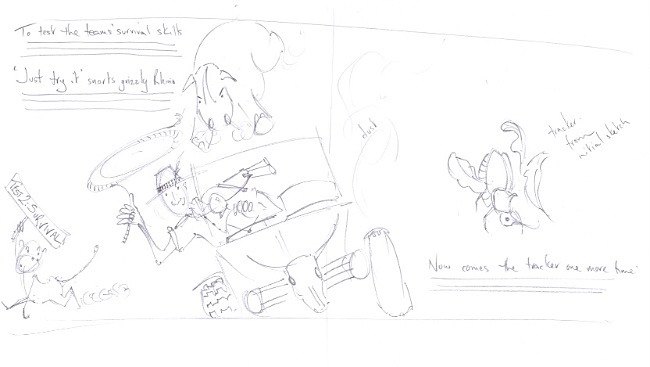
How has your background and location shaped your work?
Quite a few years passed by between the start of and the end of this book. It involved a change of countries for Ralph and, a few years later, also for my young family. Looking back, there is quite a difference between my first, more simple sketches to the final much more detailed artworks. The years in between gave me time to explore and develop my style and experience and understand more of the Kenyan bush, the vast landscapes and wide rolling skies, colours and seasons and observe animals in the wild like the cheeky baboons and explorative ants.
What is your working process?
I make a very rough pencil sketch storyboard of the whole book to work out what goes where. I then formalise this with more detailed pencil sketches. With the use of a light box I then go over the outlines with a dip pen and black Indian ink. Then fill in the detail with paint brush and coloured ink. The final pages are then photographed and put onto computer for tidying up before being sent off for compiling into the book.
Quite a few years passed by between the start of and the end of this book. It involved a change of countries for Ralph and, a few years later, also for my young family. Looking back, there is quite a difference between my first, more simple sketches to the final much more detailed artworks. The years in between gave me time to explore and develop my style and experience and understand more of the Kenyan bush, the vast landscapes and wide rolling skies, colours and seasons and observe animals in the wild like the cheeky baboons and explorative ants.
What is your working process?
I make a very rough pencil sketch storyboard of the whole book to work out what goes where. I then formalise this with more detailed pencil sketches. With the use of a light box I then go over the outlines with a dip pen and black Indian ink. Then fill in the detail with paint brush and coloured ink. The final pages are then photographed and put onto computer for tidying up before being sent off for compiling into the book.
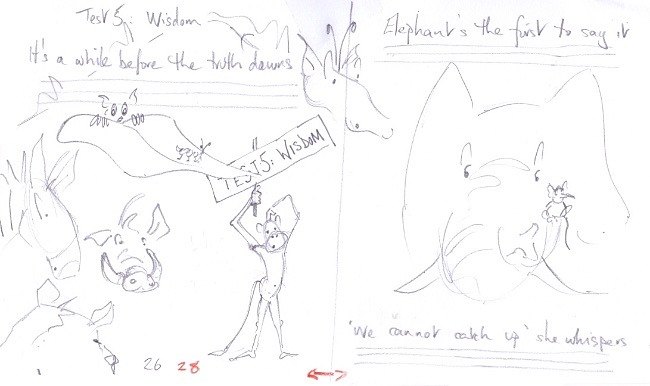
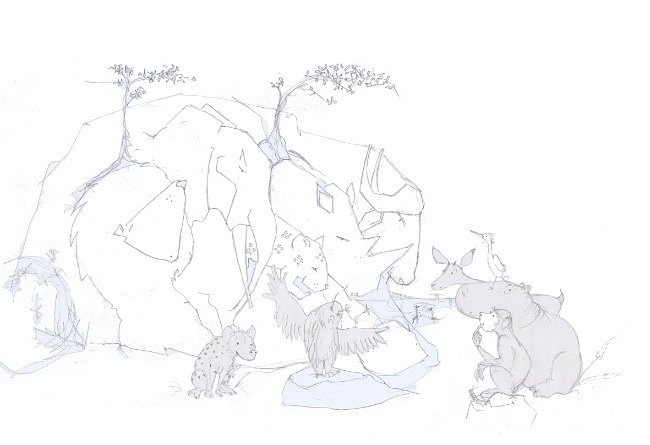
After nearly 20 years in Kenya, I’m convinced I will never run out of subject matter for my illustrations. Whether it’s the vast and beautiful landscapes, the rolling skies, or sweeping plains dotted with wondrous animals – here, like much of Africa, inspiration lies around every corner.
For The Small Five, I’ve used some of the most evocative landscapes in Kenya – places where both the Small and Big Five live, and which visitors (and David Attenborough fans) may recognise. The backdrop I’ve drawn on, with some artistic license, is the Maasai Mara’s open plains and long escarpment, made famous by the annual migration of wildebeest from Tanzania’s Serengeti. The Serengeti has a similar terrain to the Mara, but is dotted with rocky outcrops called kopjes – one of which features in the opening scene of our story.
What’s been your favourite feedback?
I think the best compliment I have ever received is from an admirer who professed to collecting and hanging my illustrations in her downstairs toilet. I first was a little disheartened but then on reflection, I realised that actually, it is the one place in the house where you can just sit and look for a length of time, every day! She then went on to say that each time she looks at my artwork, she found something new which gave me a lovely boost and makes me want to capture more intricacies to make people look longer and harder at my work.
For The Small Five, I’ve used some of the most evocative landscapes in Kenya – places where both the Small and Big Five live, and which visitors (and David Attenborough fans) may recognise. The backdrop I’ve drawn on, with some artistic license, is the Maasai Mara’s open plains and long escarpment, made famous by the annual migration of wildebeest from Tanzania’s Serengeti. The Serengeti has a similar terrain to the Mara, but is dotted with rocky outcrops called kopjes – one of which features in the opening scene of our story.
What’s been your favourite feedback?
I think the best compliment I have ever received is from an admirer who professed to collecting and hanging my illustrations in her downstairs toilet. I first was a little disheartened but then on reflection, I realised that actually, it is the one place in the house where you can just sit and look for a length of time, every day! She then went on to say that each time she looks at my artwork, she found something new which gave me a lovely boost and makes me want to capture more intricacies to make people look longer and harder at my work.
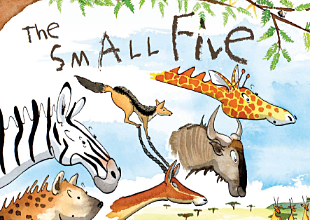
The Small Five
You’ve probably heard of Africa’s ‘Big Five’: the lion, leopard, buffalo, rhino and elephant. But did you know there are five little animals who share their names, and can fit in the palm of your hand? See what happens when the ‘Small Five’ go up against their big cousins – in a battle of wit, wills, and some extraordinary skills! A little rhyme with a big heart.
find out more
find out more
Comments (0)
No comments have been submitted yet.
Why not be the first to send us your thoughts
Leave A Comment
Thank you for your comments,
they will appear shortly once approved.
TOPICS
RECENT POSTSHAVE YOU SEEN...1
Billy Bear's Brown Hair by Dina O.NasrSeptember 25th, 20252
The Slug Who Flew by Daniel CouzensSeptember 25th, 20253
Hannah Welch - Some Brothers and Some SistersSeptember 25th, 20254
Meet Wendy Goucher, author of Eesha and the Mud Monster MysteryMarch 11th, 20245
Ride the latest wave with Samantha Bell, author of The Girl Who Saved the Ocean.April 21st, 20231
Meet and Greet - Introducing the Kids to Your Partner for the First Time by Rachel BraceJuly 28th, 20212
Top Tips on How to Write a Junior Fiction/Middle Grade BookJuly 30th, 20213
Meet Chi Mary KaluOctober 29th, 20194
Get to Know Beverly Jatwani, Author of Pedro the Puerto Rican Parrot!May 5th, 20215
Inside the Inspiration for The Great Guinea Pig Adventures with Hollie SmithNovember 24th, 2021